P. Prologue: Getting to Know the BlackBerry Curve Models

It is always good to start at the beginning when learning about a new device. Doing so allows you to learn about something from the ground up. If you have owned other BlackBerry models before, you may want to skip ahead to the chapters that will be most useful to you. If you have never used a BlackBerry, read on.
BlackBerry Curve 8300 Series
This was the very first BlackBerry Curve that Research In Motion (RIM) released, in June 2007. The BlackBerry Curve was a revolutionary BlackBerry, because prior to this original BlackBerry Curve 8300, full-keyboard BlackBerry models were very corporate, very purpose-built for the enterprise world of businesspeople. This BlackBerry added consumer features such as multimedia, 1/4″ stereo headphone jack, expandable storage, and a camera.

The original BlackBerry Curve was, and still is, very popular. RIM released variants of this model to address certain markets.
BlackBerry Curve 8310
The BlackBerry Curve 8310 is the same as the Curve 8300 in every way, except that it includes an onboard Global Positioning System (GPS) receiver.
BlackBerry Curve 8320
The BlackBerry Curve 8320 is the same as the Curve 8300 in every way, except that it includes an additional Wi-Fi radio onboard. This allows it to make use of Wi-Fi hot spots and the amazing cost-saving feature called Unlicensed Mobile Access (UMA).

BlackBerry Curve 8330
This BlackBerry Curve variant works on the Code Division Multiple Access (CDMA) and Evolution Data Only (EVDO) networks. The 8330 also includes a GPS receiver but no Wi-Fi radio.

BlackBerry Curve 8350i
In December 2008, the BlackBerry 8350i was released. This variant of the Curve is built for the Integrated Digital Enhanced Network (iDEN). This is typically used by blue-collar workers because it has a Push To Talk (PTT) feature that acts like a two-way radio or walkie-talkie. This last Curve 8300 variant also has a Wi-Fi radio and a GPS receiver.
To summarize, the original BlackBerry Curve 8300 has five variants:
• BlackBerry Curve 8300 (Original Curve, GSM/EDGE)
• BlackBerry Curve 8310 (GSM/EDGE, GPS receiver)
• BlackBerry Curve 8320 (GSM/EDGE, Wi-Fi radio plus UMA)
• BlackBerry Curve 8330 (CDMA/EVDO, GPS receiver)
• BlackBerry Curve 8350i (iDEN, PTT, GPS receiver, Wi-Fi radio)
All the original BlackBerry Curve 8300 variants share the following characteristics:
• 320×240 pixel Quarter VGA (QVGA) screen
• 2-megapixel camera with a flash
• Same keyboard layout and size
• Trackball navigation
BlackBerry Curve 8900

The BlackBerry Curve 8900 built on the success of the Curve 8300 series and took the BlackBerry Curve brand to the next level. The BlackBerry Curve 8900 does not have variants—yet. The BlackBerry 8900 is a GSM device. No CDMA or other variants exist.
The BlackBerry Curve 8900 has the following characteristics:
• 480×360 pixel Half VGA (HVGA) screen
• 3.2-megapixel camera with a flash and autofocus
• Trackball navigation
BlackBerry Curve 8520

The latest BlackBerry Curve is the Curve 8520, a mixture of the first two Curves with a twist. Even though the BlackBerry Curve 8520 is the newest Curve, it has the original Curve’s 320×240 pixel screen and 2-megapixel camera.
The Curve 8520 does have some interesting features. It uses an optical track-pad instead of a trackball for navigation. This trackpad works like a touchpad on a laptop and reduces the moving parts of the BlackBerry Curve 8520 to zero. The Curve 8520 also has external dedicated multimedia buttons on the top for play/pause, fast-forward, and rewind.
The BlackBerry Curve 8520 has the following characteristics:
• 320×240 pixel Quarter VGA (QVGA) screen
• 2-megapixel camera without a flash
• Trackpad navigation
Note
Use the RIM-provided case or one you’ve purchased. It protects the vulnerable trackball, data port, and screen from damage.
All RIM devices have a one-year warranty to cover any manufacturing defects. A cracked screen, chipped case, nonfunctioning or missing trackball, damaged USB port, or drowned (water-damaged) BlackBerry are not covered by RIM’s one-year warranty.
The BlackBerry Curve’s External Features
The outside of any device is the part you will interact with the most, so let’s start there.
BlackBerry Curve 8300 Series (8300, 8310, 8320, 8330, 8350i)
BlackBerry Curve 8300: Top
• Mute button
• Two speaker holes

BlackBerry Curve 8300: Left
• 3.5mm headphone jack (with the exception of the 8350i)
• Mini-USB port for charging and synchronizing
• Left-side convenience button (voice dialing)

BlackBerry Curve 8300: Right
• Volume up/down buttons
• Right-side convenience button (camera)
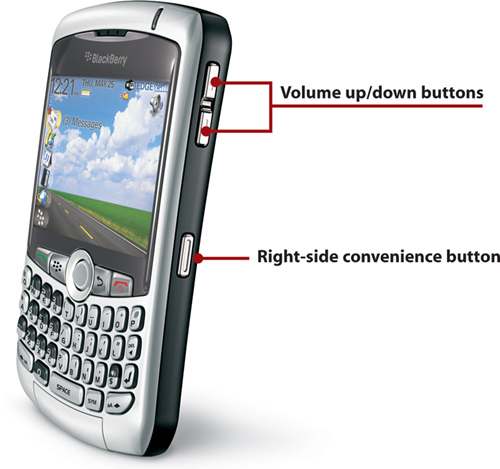
BlackBerry Curve 8300: Back

• 2-megapixel camera with a flash
• Self-portrait mirror
• Battery door and latch
BlackBerry Curve 8300: Front

• Trackball for navigation
• Call key
• End key
• Menu key
• Escape key
• QWERTY keyboard
BlackBerry Curve 8900
BlackBerry Curve 8900: Top
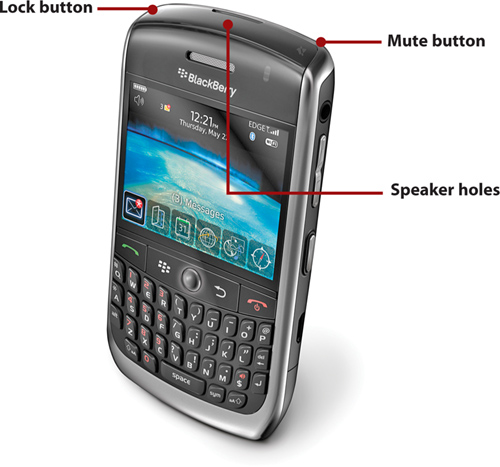
• Mute button
• Lock button
• Two speaker holes
BlackBerry Curve 8900: Left

• Left-side convenience button (defaults to voice dialing)
BlackBerry Curve 8900: Right

• Volume up/down button
• Right-side convenience button (camera)
• Micro-USB port for charging and synchronization
BlackBerry Curve 8900: Back

• 3.2-megapixel camera with a flash and autofocus
• Battery door and latch
BlackBerry Curve 8900: Front

• Light-emitting diode (LED)
• Trackball for navigation
• Call key
• End key
• Menu key
• Escape key
• QWERTY keyboard
BlackBerry Curve 8520
BlackBerry Curve 8520: Top

• Multimedia buttons (rewind, play/pause, fast-forward)
• Two speaker holes
BlackBerry Curve 8520: Left

• 3.5mm headphone jack
• Micro-USB port for charging and synchronizing
• Left-side convenience button (voice dialing)
BlackBerry Curve 8520: Right

• Volume up/down button
• Right-side convenience button
BlackBerry Curve 8520: Back
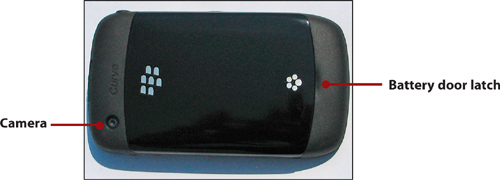
• 2-megapixel camera
• Battery door and latch
BlackBerry Curve 8520: Front

• Optical trackpad for navigation
• Call key
• End key
• Menu key
• Escape key
• QWERTY keyboard
Navigation and Typing
Navigating and typing are very important tasks, so let’s briefly go over the basics.
Navigating
To navigate around screens and menus on your BlackBerry Curve, you must use the trackball, or the trackpad with the BlackBerry Curve 8520.
Lightly touch the trackball with your thumb. Move your thumb to roll the trackball in all directions to move around screens and menu options.
Press the trackball to make a selection on the screen. Pressing the trackball is the same as clicking a mouse on a computer.

With the trackpad on the BlackBerry Curve 8520, lightly press your thumb on the trackpad and move it in all directions to move around screens and menus.
Press the trackpad to make a selection on the screen. Pressing the trackpad is the same as clicking a mouse on a computer.
If you are in a screen and you need to go back one step or screen, click the Escape key to the right of the trackball or trackpad.
To exit any program and return to the BlackBerry Home screen, click the End key.
The End button also doubles as the End Call key when you are on a call.
To bring up the phone application or to answer an incoming call, click the Call key.
When you want to bring up a menu on the BlackBerry Curve, press the trackball or trackpad. Think of this like clicking a mouse button. When you click the trackball or trackpad, a short menu appears on the screen. The short menus usually contain the choices you are looking for, so simply scroll up or down using the trackball or trackpad, and click to select the menu item.

If you want to bring up the full menu, click the Menu key, which is to the left of the trackball or trackpad. Again, scroll up or down the menu, and click to select your choice.
The BlackBerry Curve has two main screens. The first is called the Home Screen. It shows all your icons and folders. Folders are a way to group certain applications, such as Instant Messaging (IM) clients and games.

At the top of the screen, you can see a battery indicator; the time; indicators for unread messages, IM, or social networking (such as Facebook); a Bluetooth icon, a signal strength meter, and a Wi-Fi icon. You also see the cellular network you are connected to and the name of a Wi-Fi hot spot if you are connected to one.
The other main screen is called the Today screen. At the bottom of the Today screen, you see the top row of icons from the Home screen. Depending on the theme you use for your BlackBerry Curve (discussed in Chapter 11), these icons can also be along the left or right sides of the Today screen. At the top of the Today screen, you see the same indicators as on the Home screen.
Typing
To type on your BlackBerry Curve, use the full keyboard under the screen. To type one of the alternative symbols on one of the keys, hold down the Alt key while pressing the desired key. For example, to type an exclamation point, hold down the Alt key and press the B key.

If you want to type a single capital letter, hold down the desired key for half a second. The letter changes to uppercase. To type a series of capital letters, engage the Caps Lock by holding down the Alt key and pressing the right-side Shift key. If you need to type a series of numbers or any series of alternative symbols, engage the Alt Lock by holding down the Alt key and pressing the left-side Shift key.
To select multiple lines of text, press and release the left-side Shift key, and use the trackball or trackpad to scroll up or down to select one or more lines of text.

To select one or more letters, press and keep holding the left-side Shift key, and use the trackball or trackpad to scroll left or right to make the selection.

To copy your selection, press the Menu key and choose Copy.

To paste the selected text, place the cursor where you want to paste the text, press the Menu key, and choose Paste.
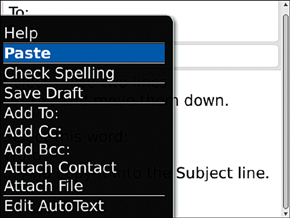
Installing the BlackBerry Desktop Software on Your Computer
The BlackBerry Curve is a smartphone that can operate without connecting to a computer. However, if you want to synchronize it with your calendar and address book, move multimedia onto your BlackBerry, perform a backup, or upgrade the device firmware, you need to install some software on your computer and connect your BlackBerry Curve using its USB cable.
Download the BlackBerry Desktop Software at http://na.blackberry.com/eng/services/desktop/. Select Download BlackBerry Desktop Software Including Service Packs. On the next screen, use the drop-down box to select BlackBerry Desktop Software 4.7, and click Next.
On the next screen, you see a list of a few versions of the software. You see these versions:
• Multilanguage without Media Manager
• Multilanguage with Media Manager
• English without Media Manager
• English with Media Manager
For the purposes of this book, it would be better if you selected the version that includes the Media Manager. We discuss the Media Manager in much more detail in Chapter 3, “Listening to Audio and Watching Video,” so it would be easier if you installed it now.
When the file has been downloaded to your computer, double-click it to start the installation.
>>>Step-by-Step: Installing BlackBerry Desktop Manager on Microsoft Windows
1. On the first screen, click Next.

2. On the next screen, select your country or region, and click Next.

3. On the next screen, accept the agreement, and click Next.
4. On the next screen, click Next.
5. On the next screen, select the Typical installation, and click Next.
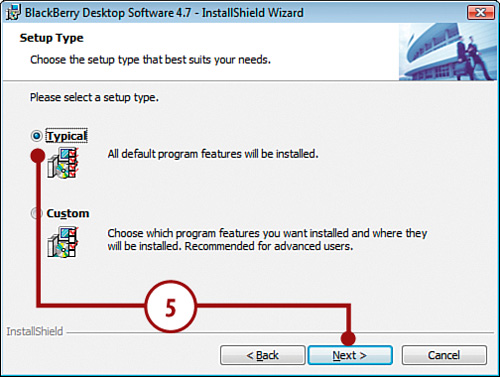
6. On the next screen, select Integrate with a personal email account, and click Next.
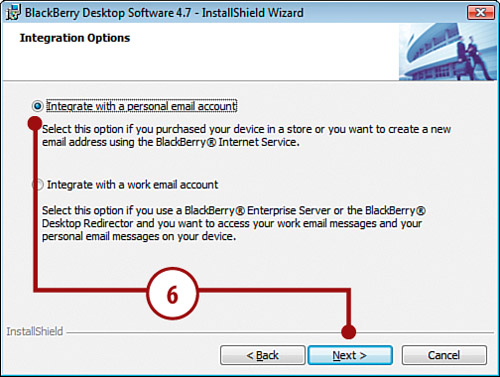
7. On the next screen, leave all options checked, and click Install.
8. When the installation is complete, you are asked to reboot your computer. Choose Yes, and allow your computer to reboot.
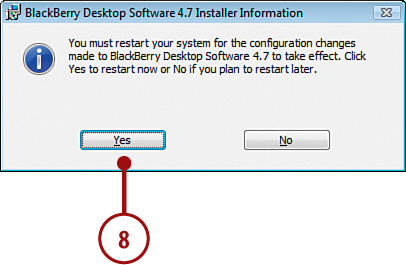
When your computer reboots, the BlackBerry Desktop Manager starts and asks you to connect your BlackBerry. For now, do not connect your BlackBerry, and click OK.
Installing PocketMac for BlackBerry and Missing Sync for BlackBerry on the Apple Macintosh OS X
If you use an Apple Macintosh running OS X, you have two options—Missing Sync for BlackBerry by Mark/Space, or PocketMac for BlackBerry.
Note
During post-production on this book, RIM released BlackBerry Desktop Manager for Mac. While it is too late to include it in this book, we will write a companion article on it at http://www.MyBlackBerryCurve.info.
BlackBerry Desktop Manager for Mac OS X is free and has the same functionality as the Windows version.
This book covers both PocketMac for BlackBerry and Missing Sync for BlackBerry, but we encourage you to choose only one of these applications, because you cannot install both of them on your Mac; you must pick one or the other. PocketMac for BlackBerry is available for free from the BlackBerry website, whereas Missing Sync costs $39.95.
>>>Step-by-Step: PocketMac for BlackBerry
1. Download PocketMac for BlackBerry and Driver Update for PocketMac at http://na.blackberry.com/eng/services/desktop/mac.jsp.
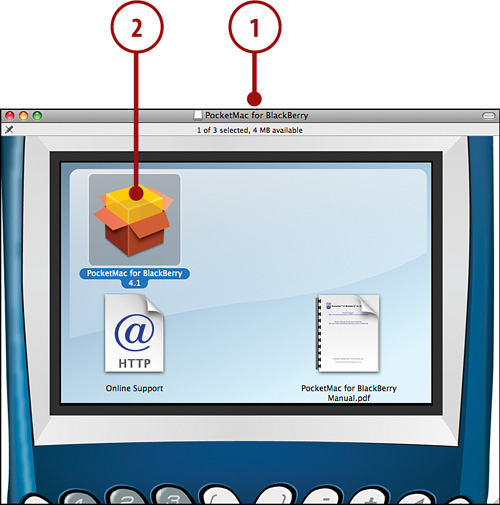
2. After both files have been downloaded, you see both icons on your desktop. Double-click the icon labeled PocketMac for BlackBerry. The PocketMac for BlackBerry installer opens. Double-click the icon labeled PocketMac for BlackBerry 4.1.
3. The PocketMac installer prompts you to enter your password to continue the installation. Type your Mac account password, and click OK.

4. Click Next on the Release Notes and License Agreement screens. Then, on the Installation Type screen, click Install.

5. The next screen warns that no applications can be running during the installation. Click the Continue button. All the applications are closed, and the installation continues.
6. When the installation is complete, you see a message asking you to reboot your Mac to complete the installation. Click the Restart button, and your Mac restarts.

7. After your Mac reboots, you need to install the Driver Update. Because you rebooted, the Driver Update icon is no longer visible on your Desktop. You can find it in the Downloads folder under your user folder. Double-click the icon labeled DriverUpdateXXX.dmg, where XXX represents the version of the driver update.

8. The Driver Update installer opens. Double-click the icon to begin the installation.

9. On the Select Destination screen, select your Macintosh’s hard drive. This is usually called Macintosh HD. Click the Continue button.
10. When the installation is complete, again you are asked to restart your Mac. Click the Restart button.
>>>Step-by-Step: Missing Sync for BlackBerry
1. Download Missing Sync for BlackBerry at http://www.markspace.com/products/blackberry/blackberry-sync-mac-software.html.

2. Double-click the file to start the installation. The Missing Sync for BlackBerry Main Installer screen appears. Double-click the icon labeled Missing Sync for BlackBerry Installer.
3. Unlike PocketMac for BlackBerry, Missing Sync for BlackBerry requires a piece of software to be installed on your BlackBerry Curve to synchronize it with your Mac. The installer’s Introduction screen reminds you of this and tells you where to download it directly to your BlackBerry.

4. When you get to the Destination screen, click the hard drive where you want to install Missing Sync for BlackBerry. This is usually the hard drive called Macintosh HD. After you make the selection, click Continue.

5. Click Continue on the next few screens, and allow Missing Sync for BlackBerry to be installed. You need to reboot your Mac at the end of the installation.
Using This Book
My BlackBerry Curve was written to help you become very familiar with your BlackBerry Curve so that you can use it as efficiently as possible, get more done with it, and personalize it. If you have already flipped through the book, you have noticed that everything is explained through the help of full-color screenshots of a BlackBerry Curve. Many step-by-step instructions help guide you through each process.
Your BlackBerry Curve can synchronize with Microsoft Windows and Apple Mac OS X, so we cover both platforms. All procedures involving synchronizing with a computer are covered in Windows and OS X.
Although all the screenshots in this book were taken from a BlackBerry Curve 8900, anytime there are slight differences in the procedure, we mention it so that you won’t get lost. Because the BlackBerry Curve is so customizable using themes, you may sometimes find that we mention an icon or folder on the BlackBerry Home screen that you may not see. This is normally because that icon has been moved to a folder by the theme you are using. The folder normally is named appropriately, so you should be able to find it easily.





